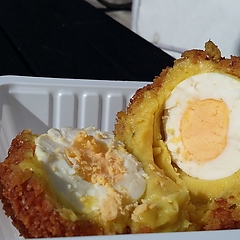The Indonesian rijsttafel (rice table) is a traditional combination of dishes from various Indonesian food cultures. The rice table consists of a number of perfectly harmonised dishes. All main and side-dishes are put on the table at the same time. Everyone composes his own menu from them. It is not only about the eating itself; socialising and togetherness are equally important. The Indonesian rice table is a traditional element of festive occasions like annual events, reunions, memorials and other gatherings. The recipes for the rice table are often family recipes from the former Dutch East Indies, passed on by granny, aunty or kokkie (the cook). The one who makes the dishes of the rice table, must have sufficient knowledge and the cooking skills of the Indonesian cuisine. An Indonesian rice table consists of rice with a number of meat, fish and vegetables dishes, flanked by a number of matching side-dishes. The flavours must be well-harmonised, requiring a carefully thought out composition of the rice table.



